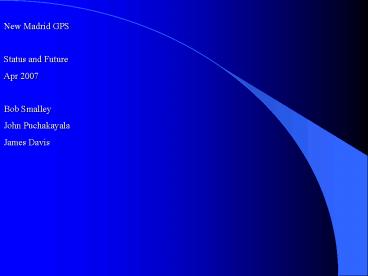New Madrid GPS - PowerPoint PPT Presentation
New Madrid GPS
(better/definitive answer needs more cGPS stations and longer measurements) ... Large amplitude (strong or weak motion) displacement 'seismometer' Conclusions ... – PowerPoint PPT presentation
Title: New Madrid GPS
1
New Madrid GPS Status and Future Apr 2007 Bob
Smalley John Puchakayala James Davis
2
Residual horizontal site velocities (Newman et
al., 1999)..
3
Is deformation occurring? (better/definitive
answer needs more cGPS stations and longer
measurements)
4
Residual velocities w.r.t. stable North
America (defined using sites east of 100W and
south of 40N - wrms 0.4 mm)
Calais and DeMets, unpublished solution, Nov. 2006
5
Detecting small signal buried in larger signal No
noise
6
Detecting small signal buried in larger
signal With noise
7
New Madrid GPS Velocity Field
8
Monument comparison
9
Can high precision GPS be used to test different
models?
Elastic strain accumulation
Visco-elastic relaxation 1811-12
Parameters from Rydelek Pollitz, 1994 Pollitz,
1997 code
10
High Rate GPS (1 sec or faster)
Large amplitude (strong or weak motion)
displacement seismometer
11
Conclusions Controversial observation strain
associated with one of New Madrid fault zone
structures For crustal deformation - need
more Time Stations
12
The End
PowerShow.com is a leading presentation sharing website. It has millions of presentations already uploaded and available with 1,000s more being uploaded by its users every day. Whatever your area of interest, here you’ll be able to find and view presentations you’ll love and possibly download. And, best of all, it is completely free and easy to use.
You might even have a presentation you’d like to share with others. If so, just upload it to PowerShow.com. We’ll convert it to an HTML5 slideshow that includes all the media types you’ve already added: audio, video, music, pictures, animations and transition effects. Then you can share it with your target audience as well as PowerShow.com’s millions of monthly visitors. And, again, it’s all free.
About the Developers
PowerShow.com is brought to you by CrystalGraphics, the award-winning developer and market-leading publisher of rich-media enhancement products for presentations. Our product offerings include millions of PowerPoint templates, diagrams, animated 3D characters and more.































